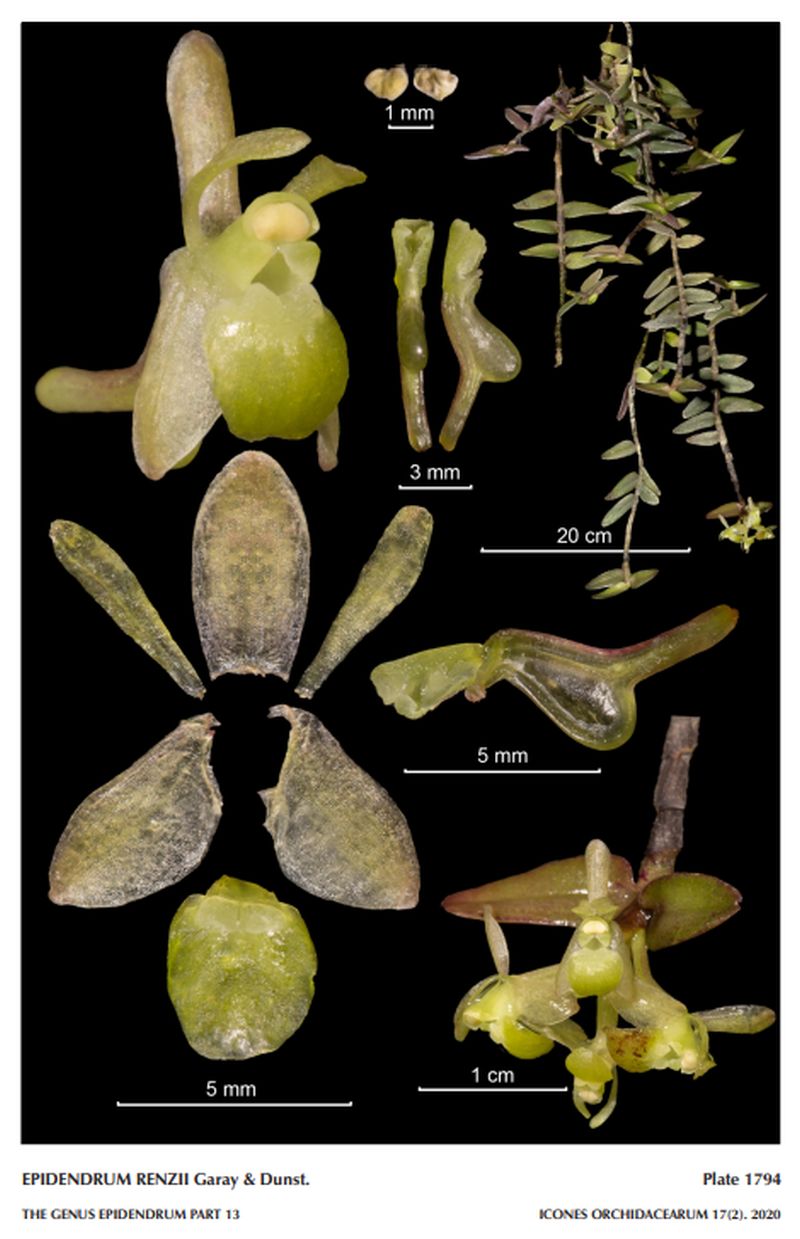

Epidendrum renzii Garay & Dunst. 1965 GROUP Nanum SUBGROUP Renzii
TYPE LCDP by © R. Jiménez M. & A. Cisneros/TYPE Photo by R. Jenny and The AMO Herbario Website



Common Name Renz' Epidendrum [Swiss Botanist and Orchid Collector in northern South America 1900's]
Flower Size 1/4" [6 mm]
Found in Ecuador and northwestern Venezuela in humid forests low to the ground at elevations of 1940 to 2300 meters as a small sized, cool to cold growing, pendant epiphyte with elongate, cane-like terete at base, somewhat laterally compressed towards the apex, thin, pendulous; the new stem originating from apical and sub-apical internodes of the previous stem carrying 5 to 33, distributed throughout the stems, articulate, distichous, coriaceous, twisted at base so lies in the same plane as the stem as in Dichaea, narrowly ovate to lanceolate, apex obtuse, unequally bilobed, minutely apiculate, margin entire, spreading leaves that blooms in the spring on a terminal, arising through 1 to 2, elliptic, oblique, apex obtuse, conduplicate, somewhat imbricated at the base, totally covering the peduncle and rachis, peduncle .08" [2 mm] long; rachis .02 to .04" [0.5 to 1.0 mm] long, .8 to 1" [2.0 to 2.5 cm] long including the flowers, sub-umbellate, simultaneously 4 flowered inflorescence with much shorter than the ovary, widely triangular, acute, embracing floral bracts and carrying green to pale greenish brown flowers with the sepals dorsally marked with small tenuous purple dots, lip and column pale green, calli and disc slightly paler green, anther creamy white.
"Epidendrum renzii Garay & Dunst., belongs to the GROUP Nanum , which is characterized by the Dichaea-like pendent stems, the inflorescence produced by pairs of opposite flowers, without spathaceous bracts, but with prominent floral bracts, and the GROUP Nanum SUBGROUP Renzii which has an ecallose, entire lip. The species is recognized by the longer stems, 4, pale green flowers with a wine-red lip, in two opposite pairs, a prominent vesicle on the underside of the ovary, resupinate flowers, oblong to oblanceolate petals. Epidendrum pogonochilum Carnevali & G.A.Romero is very similar but the flowers have the apical half of the lip winered, sometimes diluted, lip .312 to .32" x .24" [7.8 to 8 x 6 mm], ovate, the apical half somewhat narrowed and abruptly recurved, and the petals oblong, vesicle only twice as thick as the pedicellate ovary, not scrotum-like. Epidendrum nanoecallosum has short, pendent, branching habit, 8 to 9 small flowers, the sepals.24 to .26" [ 6 to 6.5 mm] long, an elliptic, ecallose, entire lip, and a very prominent, fleshy, entire, clinandrium-hood. Epidendrum nanodentatum has two, opposite, non-resupinate, pinkish colored flowers, a triangular, ecallose lip, and the short, lanceolate, acute petals, with an acute tooth on either side of the apex of the column. Epidendrum nanosimplex Hágsater & Dodson is also similar, but has 6 to 7, resupinate, pale green and white flowers in opposite pairs, shorter sepals .16 to .24" [4 to 6 mm] long, narrowly oblanceolate petals, a truncate column, and the triangular, ovate lip with a pair of prominent globose calli." Adapted from E nanoecallosum Icones Plate 1267 Hagsater etal 2009/Hagsater etal 2020
Synonyms
References W3 Tropicos, Kew Monocot list , IPNI ; Venezuelan Orchids Vol 3 Dunsterville & Garay 1965 drawing fide; Flora de Venezuela Foldats Volumen XV Part 3 1970 drawing fide; Orchids of Venezuela, An Illustrated Field Guide Dunsterville & Garay 1979 drawing fide; Native Colombian Orchids Vol 2 COS 1991 photo fide; Orchids of Venezuela [An illustrated field guide] Vol. 1 Ramiro and Carnevali 2000 drawing fide; Orquideas Nativas del Tachira Cesar Fernandez 2003 photo fide; Icones Orchidacearum Vol 8 Plate 857 Hagsater & Sanchez 2006 see recognition section; Icones Orchidacearum Part 12 Plate 1267 Hagsater 2009 see recognition section; Orquideas, Tesoro de Colombia Vol 2 Ortiz & Uribe 2017 drawing good; Orquideas, Tesoro de Colombia Vol 2 Ortiz & Uribe 2017 as E aff renzii photo ok; Icones Orchidacearum 16[2] Plate 1691 Hagsater & Sanchez 2018 see recognition section; Icones Orchidacearum 17(1) Plate 1788 Hagsater & Jimenez 2019 see recognition section; Icones Orchidacearum 17(2) Plate 1794 Hagsater & Jimenez 2020 LCDP/Photo fide;
--------------------------------------------------------------------------------------------------------------------------